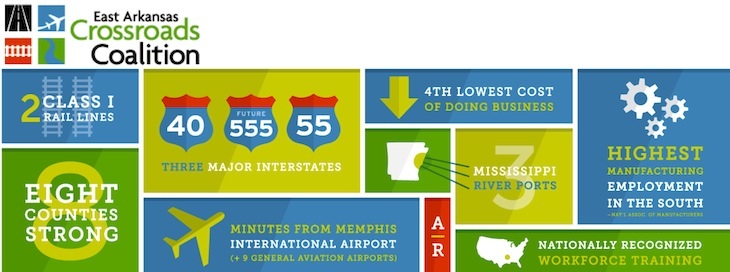East Arkansas Crossroads Coalition hopes to recruit high paying jobs to the Delta
by January 7, 2018 1:26 pm 684 views

Population stagnation, limited wage and job growth have kept many counties in eastern Arkansas in the Mississippi Delta Region mired in mediocre economic growth. One organization comprised of eight counties in the region hopes to buck that trend.
The East Arkansas Crossroads Coalition hopes to attract jobs and raise the median income in the area, Cross County/Wynne Chamber of Commerce President Christopher Clifton told Talk Business & Politics.
Civic and business leaders in the eight counties represented in the coalition – Cross, Poinsett, Woodruff, St. Francis, Lee, Monroe, Phillips, and Crittenden – believe a regional approach to economic development is the best approach, he said. The Coalition hopes to emulate the economic growth that has occurred in Northwest Arkansas in recent years.
“We all share the same labor market. It makes sense for us to pool our resources and work together,” Clifton said.
Unemployment rates in the region range from around 3.5% to 5.7% in individual counties. Low wages and poverty are two problems that need to be addressed in the eight county area, according to the U.S. Census Bureau. The national median income is about $57,000. In the eight-county region, Crittenden County has the highest median income $39,407, slightly ahead of Cross County at $39,306. Poinsett and St. Francis counties have an average around $35,000, while Woodruff and Monroe counties have income levels around $31,000. Lee and Phillips counties have median incomes in the mid-$25,000 range.
Poverty is another ongoing issue in the region. About 12.7% of U.S. citizens live in poverty. In Lee County, the rate is 35.9%, and 32.3% in Phillips County. Poinsett County had the lowest rate in the area with 22.7%. The rest of the counties hover around 28% on average.
To tackle these economic issues, EACC formed to lure better paying jobs to the region. Communication between the counties has been a vital tool in development. An example of that would be the new textile manufacturer slated to open in Forrest City. China’s largest cotton textile manufacturer, the Shandong Ruyi Technology Group, will invest $410 million to retrofit a 1.4 million square foot cotton-spinning, garment factory in Forrest City. It will create up to 800 jobs that pay on average $15 per hour. The plant could use up to 200,000 tons of Arkansas cotton per year. Arkansas is the fifth largest cotton producer among all states, producing more than 840,000 bales in 2016.
There are few structures in the eight county region that could support a project like this and it would be hard to find a place to build such a facility, Clifton said. A facility of this magnitude will employ people far beyond Forrest City and will use cotton which is grown in abundance in the region, he said. The impact to the surrounding area would be zero if the plant didn’t locate in Forrest City, so it’s incumbent to do whatever it takes to help make it happen, he said.
Another point of emphasis has been the development of the region’s workforce. An emphasis on science, technology, engineering, and mathematics, or STEM has been promoted. Industries are in desperate need of workers with those skills, and communities and regions that develop a workforce with those skill sets will have a competitive advantage, Clifton said. STEM starts at the high school level and goes through college.
“We have to close the skills set gap,” he said. “We have to do a better job of creating a higher skilled worker that goes into the labor force.”
EACC has conducted several “familiarization tours” with prospective industrial clients. The tours allow economic developers to gauge what particulars companies need. There are some partners that could be a “better fit” and others in EACC are doing everything they can do to make that a reality, he said.
“It only makes sense to share our resources,” he said.
